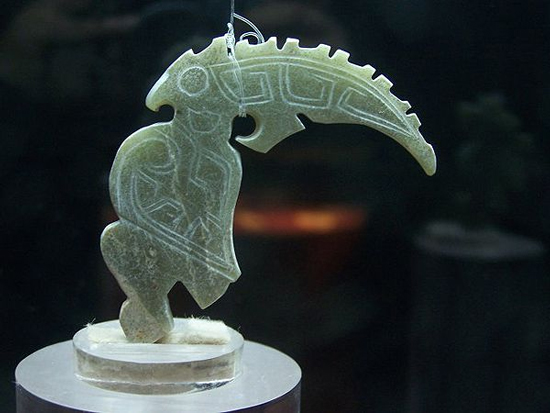Xia is the first slave country in Chinese history. According to ancient literature, Xia Dynasty is a country that advocates jade civilization. As the jade of the first dynasty of Chinese civil society, it is a historical summary of the inheritance of prehistoric jade. On the basis of the overall simple and solemn style, it innovates the shape, ornamentation and style of some artifacts; on the other hand, it is the jade of Shang Dynasty. The development of the foundation laid a new era for the aesthetic characteristics of the jade in the new era, and played a role in the past and the future. The Erlitou culture jade that is currently known is the representative form of the Xia Dynasty jade.

Jade carving is one of the important handicrafts in the Yin and Shang Dynasties. From the aspects of the design and artistic style of the unearthed jade, its achievements are no less than the bronzes known in the Shang Dynasty. The application of bronze tools in the jade craftsmanship has significantly improved the technology of the jade jade. The jade articles of the Shang Dynasty are technologically advanced in terms of modeling, carving and polishing, and there are many innovative breakthroughs. There were not many jade articles discovered in the early Shang Dynasty. There were jade, shovel, shovel, kiln, shovel, knife, and scorpion jade. The variety was small and the tanning system was rough. In the late Shang Dynasty, the jade was represented by the jade unearthed from the Yinxu Women's Tomb in Anyang. The social function of the Shang Dynasty jade has changed a lot. At this time, the jade began to turn into play, and only more than half of the decorative jade. The most amazing thing is that the Shang Dynasty has emerged as the earliest jade jade in China, Yuxi, and began to have a large number of round sculptures. It can be said that the Shang jade carving process has reached a new peak.
The Zhou Dynasty was a powerful slavery country after the Shang Dynasty and a patriarchal society with a strict class. The Zhou Dynasty paid great attention to the establishment of the ritual system. Therefore, the jade articles of Zhou Dynasty deviated from the development track of the jade articles of Shang Dynasty and developed towards the etiquette jade. The style of heavy jade in the Zhou Dynasty is extremely prosperous, and the skills of the jade jade are constantly improved, making the objects beautiful. In terms of workmanship, in addition to inheriting the Shang Dynasty double hook line, it also created a rough side of the slope line jade jade skills. In general, the Western Zhou jade does not have the lively and diverse jade articles of Shang Dynasty. Most of them are mainly in the shape of a piece, and there are few round carvings. They are too regular and slightly dull. This is not unrelated to the strict patriarchal and ritual system of the Western Zhou Dynasty.
In the Spring and Autumn Period and the Warring States Period, which lasted for more than 500 years, political lords contend for hegemony, and hundreds of academic and cultural fields contend. As iron tools replaced bronze tools, the development of productivity was greatly promoted. The jade handicraft industry also experienced a turning point in the Spring and Autumn Period and the Warring States Period. The production process was exquisite and extraordinary, and the jade carving art was brilliant. During the Spring and Autumn Period and the Warring States Period, Hetian jade was heavily input into the Central Plains. Confucian scholars combined Hetian jade and ritual studies to embody ritual thoughts with Hetian jade. The formation and development of jade culture is also the theoretical basis for the enduring Chinese jade carving art. The spiritual pillar of the 7000-year-old loves the jade fashion. The jade artifacts of the Spring and Autumn Period have evolved from the flattening and simplification of the Western Zhou Dynasty to the direction of hidden and complicated, and developed into the Warring States Period. The jade craftsmanship is more mature, and the methods of hollowing out and embossing are widely used. The world’s eye-catching Zeng Houyi The multi-section dragon and phoenix peony unearthed from the tomb, Da Yu Pei Pei, unearthed from the Wei royal family in Guwei Village, Hui County, Henan Province, all reflect the difficult craft level of the Warring States jade. During the Spring and Autumn Period and the Warring States Period, Li Yu gradually decreased, and Pei Yu increased. Common jade articles include ç®, ç’œ, ç’§, bracelets, rings, sword ornaments, and accessories. Among them, jade and dragon-shaped ornaments are the most popular, in addition to jade belt hooks and jade. And a variety of funerary jade and so on From the level of craftsmanship, the Warring States jade is the most exquisite era in the history of ancient Chinese jade crafts.
Men's Hoodies
Hoodies is basically a sweatshirt with hood.There are pullover hoodies and also zipper up hoodies.It can be worn for both casual and sports wear.There is a fitted rib cuff and bottom hem normally. Many hoodies is with a kangaroo pocket in front. The most popular fabrics for hoodies are french terry and fleece inside fabric.We can customize various kinds of logo for you. Such as printed logo, embroidery logo, rhinestone logo and so on.We can customize the hoodies based on your tech pack,your original samples and pictures.Click here:Men's Padded Jacket, Men's Puffer Jacket , Men's Denim Jacket , Men's Cargo Pants , Women's Bomber Jacket, Women's Sherpa Jacket, Women's Denim Pants are also our company's best-selling products. If you have any order requirements, please contact us!

Hoodies,Sweatshirt for Men,Hoodies for Men,Mens Hoodies Sale
Dongguan City Theshow Garment Co., Ltd , https://www.theshowjacket.com